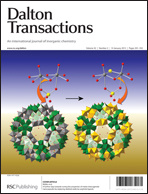The formation of [Cm(SO4)n]3−2n complexes (n = 1, 2, 3) in an aquatic solution is studied by time resolved laser fluorescence spectroscopy as a function of the ligand concentration, the ionic strength (NaClO4) and the temperature (25 to 200 °C). The experiments are performed in a custom-built high temperature cell for spectroscopic measurements at high pressures and temperatures. The single component spectra of the individual species are identified by slope analysis at every studied temperature and their molar fractions are determined by peak deconvolution of the emission spectra. The results show a strong shift of the chemical equilibrium towards the complexed species at increased temperatures. With the determined speciation, the conditional stepwise stability constants are calculated and extrapolated to zero ionic strength, using the specific ion interaction theory (SIT). The log K0n(T) values increase by several orders of magnitude in the studied temperature range. The fitting of the temperature dependency of the first and second stability constant (log K01 and log K02) requires an extended van't Hoff equation, taking into account a constant heat capacity of the reaction (ΔrC0p,m = const.). Contrarily, the temperature dependency of the log K03 is very well described by the linear van't Hoff equation, assuming ΔrC0p,m = 0. Thus, the thermodynamic standard state data (ΔrH0m, ΔrS0m, ΔrC0p,m) of the stepwise complexation of Cm(III) with SO42− are determined. Additionally, the ion interaction coefficients of the stepwise complexation reactions (Δεn) are determined as a function of the temperature. The fluorescence lifetimes of Cm(III) are recorded at different sulphate concentrations as a function of the temperature. The results give a strong indication that at T > 100 °C the first excited state of Cm(III) (6D′7/2) is effectively quenched by a temperature dependent enhancement of the energy transfer from the metal ion to OH vibrations of first shell water molecules.
![Graphical abstract: Complexation and thermodynamics of Cm(iii) at high temperatures: the formation of [Cm(SO4)n]3−2n (n = 1, 2, 3) complexes at T = 25 to 200 °C](/en/Image/Get?imageInfo.ImageType=GA&imageInfo.ImageIdentifier.ManuscriptID=C2DT31529G&imageInfo.ImageIdentifier.Year=2013)
You have access to this article
 Please wait while we load your content...
Something went wrong. Try again?
Please wait while we load your content...
Something went wrong. Try again?
![Graphical abstract: Complexation and thermodynamics of Cm(iii) at high temperatures: the formation of [Cm(SO4)n]3−2n (n = 1, 2, 3) complexes at T = 25 to 200 °C](/en/Image/Get?imageInfo.ImageType=GA&imageInfo.ImageIdentifier.ManuscriptID=C2DT31529G&imageInfo.ImageIdentifier.Year=2013)

 Please wait while we load your content...
Please wait while we load your content...